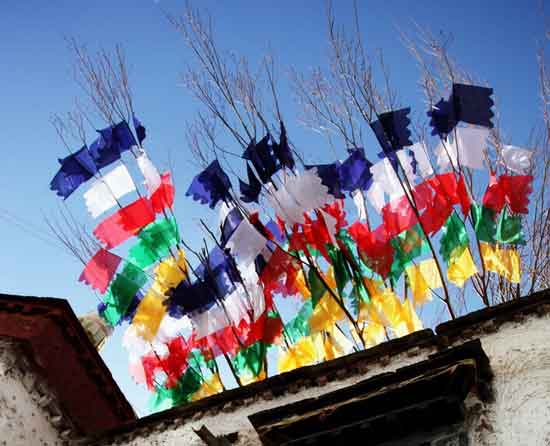What to do in Losar (II)
Day One
The housewife gets up in the dawn. She cooks a big pot of Tsampa, a mixture of brown sugar, dried milk crumbs and highland barley wine.
In the rural areas, the housewife goes out to fetch the first bucket of water from the well or river nearby for the New Year.
Legend has it that the first bucket of water is the purest and holiest. Whichever family gets it will ward off disasters in the coming year. Then the housewife go to feed livestock. She wakes up everyone of her family.
Everybody puts on new clothes and sits together in the order of family ranks. The seniors place a Chemar in the middle of the offering table, then everyone picks up a few pieces of the grains and spread them toward the sky, meaning to pray for gods, and then put some into his/her mouth.
The senior wishes the younger generations "Happy New Year", or "Tashi Delek" in Tibetan, and the younger wish the seniors “Good luck and boundless beneficence,or “Tashi Delek Peng Song Cuo” in Tibetan.
After the ceremony, the whole family sits together drinking barley wine and eating snacks. Usually people stay at home on this day. Legend has it that the first bucket of water is the purest and holiest. Whichever family gets it will ward off disasters in the coming year.
Spreading grains toward the sky means to pray for gods.
Day Two
Relatives and friends greet each other “Happy New Year”, which last for three to five days, holding Chemars and barley wine in their hands. It is a custom that guests with Chemars call loudly outside the doors, while the hosts hurry out to meet them and send back good wishes.
From the day on, folk art performers go round all places to chant local folklores, or “Zhe Ga”.
Day Three and Day Four
People pray for God of Rooftop. Prayer flags are put on the top of the roofs. Then mulberry leaves are burned to give out smokes, followed by spreading out Tsampa to give best wishes for the New Year.
Horse races are held. Tibetan operas are put on show. Relatives and friends continue to greet each other.
Day Five Plowing ceremony is held. Customs are as follows: Farmers are dress up in festival costumes. Livestock are decorated with patterned yak butter on their forehead, colorful flags on yaks’ horns and feathers, and silk ribbons on tails. Farmers carry out white stones from their houses preserved from last year and plug it into the center of their field, which is called “A Ma Se Duo,* known as the “Goddess of Protection.” Finally,farmers burn mulberry leaves to give out smokes,hanging out prayer flags,and driving yaks to plow five lines in the field around the white stone. “A Ma Se Duo” means “Golden Stone Mother”, known as the “Goddess of Protection.”
Usually the New Year celebrations last for 15 days.
Your Comment
Name E-mailRelated News
-
;
-
-

-
What to do in Losar (I)
Offering Chemars and eating “Guthuk” are two main customs for Tibetan families in Tibetan New Year or Losar.
-
-
-

-
Sutra streamer: Symbol of Tibetan culture
The sutra streamer, a flag made of cloth, silk or handmade paper with Buddhist scriptures on it is believed to bond human and God in Tibetan culture.
-
Based in Lhasa, Tibet Vista is a Tibet travel agency that specialized in Tibet permit, and Tibet tours for both private and group travelers at a local price!
•4 Days Lhasa City Group Tour from USD 460 •8 Days Everest Base Camp Group Tour from USD 850 •15 Days Mt.Kailash Group Tour from USD 1780 •2016 Tibet Train Tours from Beijing, Shanghai, Chengdu, Xining,etc










